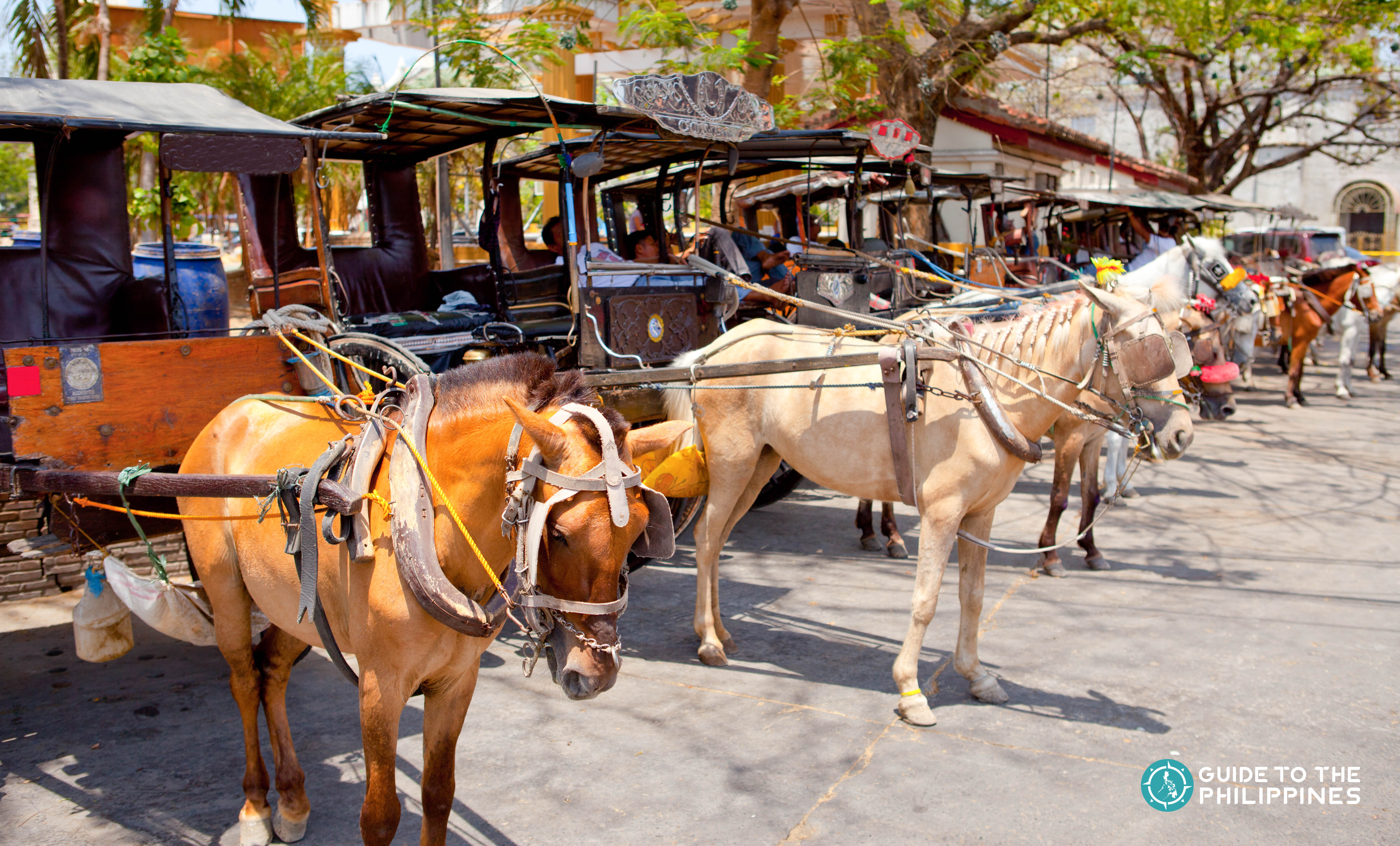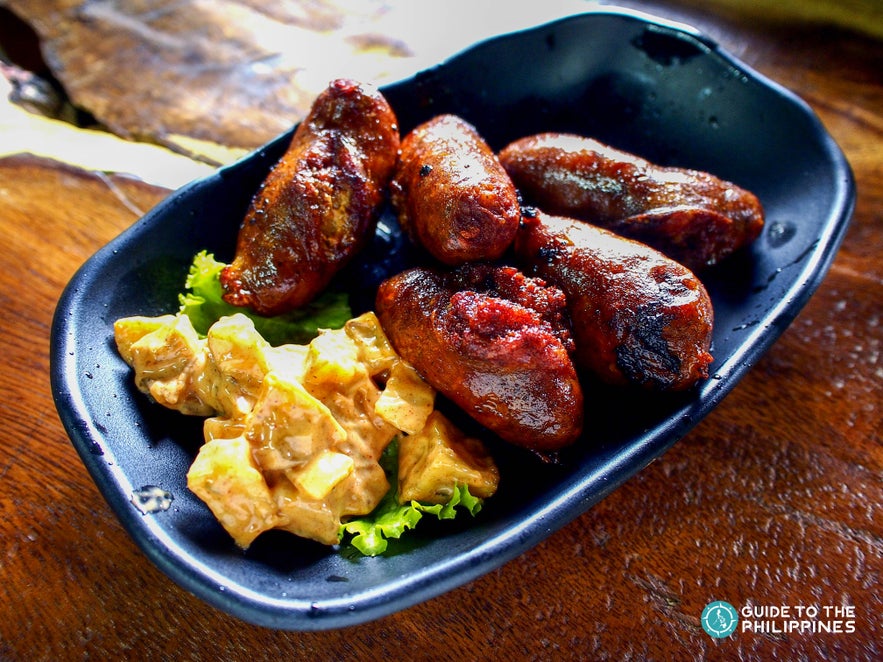
Sausages are one of those dishes that seem to appear in every cuisine. All around the world, people have found that the best way to utilize the more affordable cuts of meat is to grind them, add spices and herbs, and encase them to make sausages.
Filipino cuisine is no exception when it comes to sausages. A trip to the Philippines will most probably have you encounter, not one, but most likely several varieties of the local sausage or longganisa.
To get the best experience for your Philippine food tours, read this guide to know some of the most popular varieties of longganisa:
What is Longganisa?
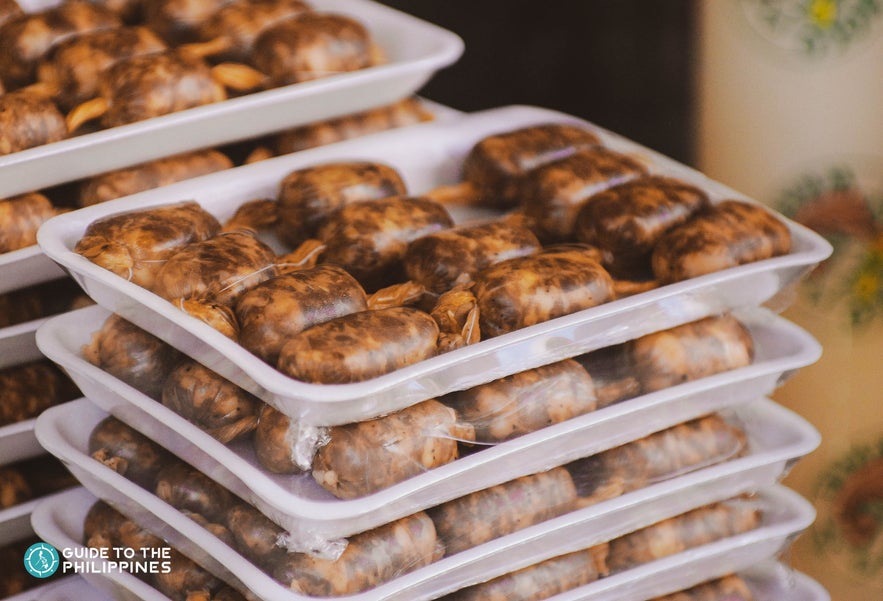
The term longganisa is derived from the Spanish term “longaniza” which is a type of Spanish sausage. With the Spanish occupation of the Philippines, the term was introduced into the language and is now the generic word for most local sausages in the Philippines.
There are some regions in the Philippines that refer to local sausages as “chorizo,” but unlike in Spain, where the two sausages have distinctions, it seems to be used interchangeably in the Philippines, depending on the region where one is staying.
Longganisa is so popular and integral in many regions of the Philippines. This is why several places in the country, from Vigan to Guinobatan to Lucban, hold yearly longganisa festivals to celebrate and promote it.
Longganisa in Philippine Culture
 Photo by the Philippine Department of Tourism
Photo by the Philippine Department of Tourism
Longganisa counts as an all-day food. In local parlance, it is an “altanghap” food, meaning it can be enjoyed for breakfast (almusal), lunch (tanghalian) or dinner (hapunan).
Despite this, longganisa is still one of the kings of the Filipino breakfast. The best way to enjoy it is to pair the longganisa with garlic fried rice (sinangag) and fried egg (itlog). When ordering in a restaurant or eatery, it is simply called “Longsilog.”
Because they are rich and savory, longganisa is best enjoyed with a side dish or condiment to cut into the richness. Most of the time, longganisa is dipped in vinegar or eaten with pickled vegetables or fruits called “atchara.”
Longganisa has crossover appeal. In fact, it has appeared on the menu of several American food joints in the Philippines, including fast-food giant McDonald’s.
Best Longganisa in the Philippines
Most longganisas are named after the region they were created or became popular in, making it easy to know where they are readily available.
Most types of longganisa fall into two general categories, “de recado” and “hamonado.” De recado refers to a more savory, salty kind of sausage, while hamonado refers to a sweeter sausage.
While there are many different varieties of longganisa, the common denominator is garlic. Very rarely is there a Filipino sausage made without copious amounts of minced garlic.
Here are some of the top must-try types of longganisa in the Philippines:
Vigan Longganisa
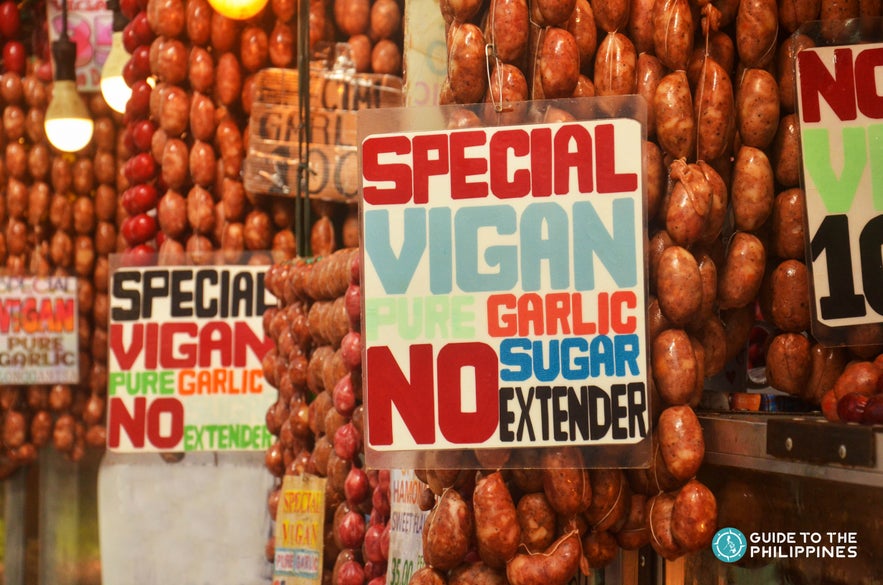
One of the more well-known types, Vigan longganisa from Ilocos employs the famously fragrant and flavorful native garlic from the Ilocos region.
With slightly larger chunks of garlic, they are very savory and perfect with some caramelized sugar cane vinegar. These are featured in another Ilocano favorite, the empanada, a must-try snack when doing Vigan tours.
Tuguegarao Longganisa

Photo by Longganisa Tuguegarao
Usually yellowish or orange in color, Tuguegarao longganisa has a wonderfully vibrant note of sourness from the vinegar marinade. The meat is also less finely ground, so there are larger pieces in the sausage.
It is sometimes known as Longganisa Ibanag/Ybanag. Don't forget to try or buy these if you're doing Tuguegarao tours.
Alaminos Longganisa

Photo by Celia's Cafe
This longganisa from Alaminos in Pangasinan is easily identifiable as each link of the sausage is sealed with a toothpick. Each link is usually small, and the meat is flavored simply with salt, pepper, and tinted with annatto seed oil/water to give it an orange hue.
In most cases, the meat is ground once, seasoned, and then ground again before going into the casing. These are a must-try or must-buy as souvenirs to complete your Pangasinan tours.
Lucban Longganisa
 Photo by Buddy's
Photo by Buddy's
Lucban longganisa in Quezon province distinguishes itself by flavoring the meat with oregano and sometimes paprika. Of course, it still has a strong flavor of garlic and vinegar, but they do have a deeper flavor, which slightly reminds of European flavors.
Calumpit Longganisa
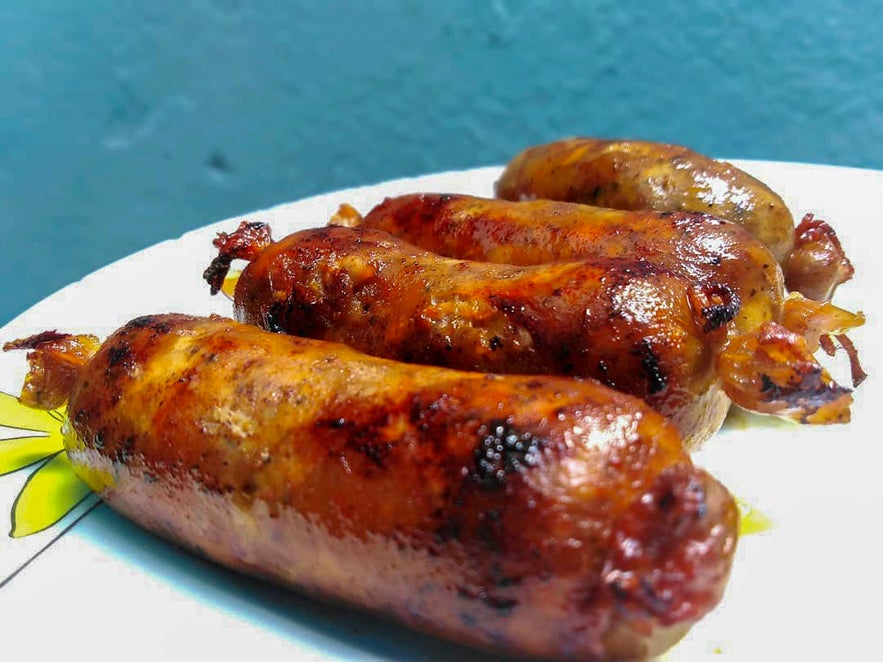
Photo by Boy Calumpit Longganisa
Sometimes referred to as the “Garlic Longganisa,” Bulacan's Calumpit longganisa actually features a more well-rounded flavor profile compared to the other sausages with hints of paprika and brown sugar complementing the garlic, salt, and pepper.
Cabanatuan Longganisa
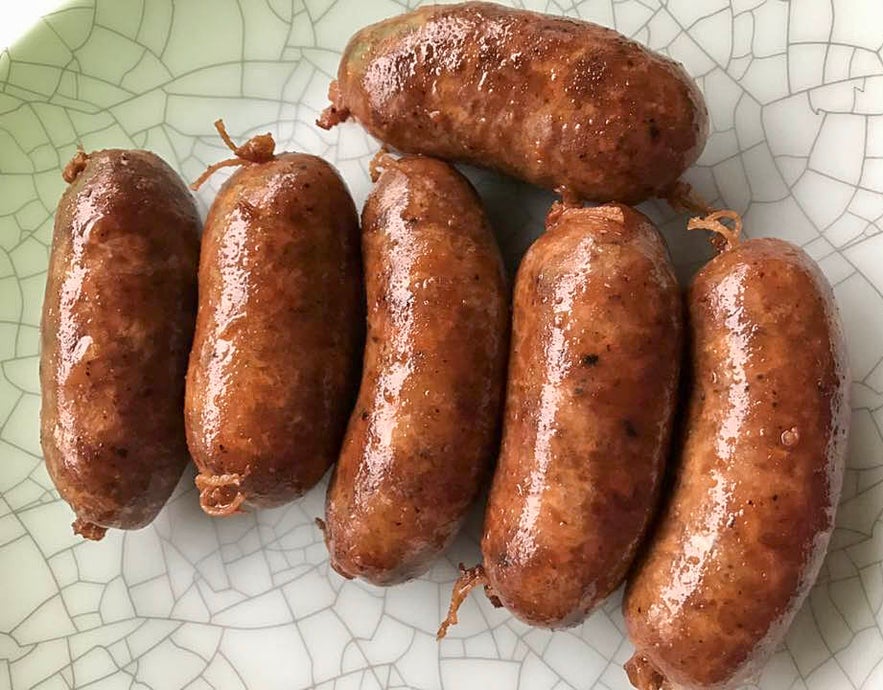
Photo by Cabanatuan's Finest Longganisa
The happy exception to the rule, Nueva Ecija's Cabanatuan longganisa, locally known as “batutay,” are made with ground beef instead of the usual pork. It also has a sweeter taste, giving the sausage a great balance between savory and sweet.
Pampanga Longganisa
 Photo by Foxy Folksy
Photo by Foxy Folksy
Rivaled only by the Vigan longganisa in popularity, this longganisa from the Culinary Capital of the Philippines, Pampanga, is sweet and usually tinted red.
This is the most commonly found version of longganisa, so when one is in Metro Manila, this is the default version usually available. It can come in two versions, in a sausage casing or “skinless.”
Chorizo
In the regions South of Luzon, from Cebu onwards in Visayas, people generally refer to longganisa as “chorizo.” The size and shape may vary depending on the region. Cebu versions, for example, may be rounder while Mindanao's Davao versions may be a little longer. The taste, however, does not vary as much.
These are the hamonado variety of longganisa, sweet with hints of garlic. These are best enjoyed grilled over charcoal, with the casings caramelizing, giving the sausages a slight smoky taste and aroma. In Boracay, the chorizo meat is shaped into a patty, grilled and served in a burger bun.
Chorizo Negrense
The sausage from the Bacolod region is flavored with both vinegar and calamansi (local citrus) together with coarse salt and soy sauce.
While it is sometimes made with casing, it seems that the more popular version has become the chorizo “pudpud” which is ground sausage. It is quite common to see these chorizos sold in small glass bottles.
Must-Try Local Longganisa
These longganisa varieties may not be as popular, as they may be difficult to procure and are not usually available outside of the provinces they are made. These, however, are tremendously flavorful and delicious, and it will be worth the effort to find them.
Imus Longganisa
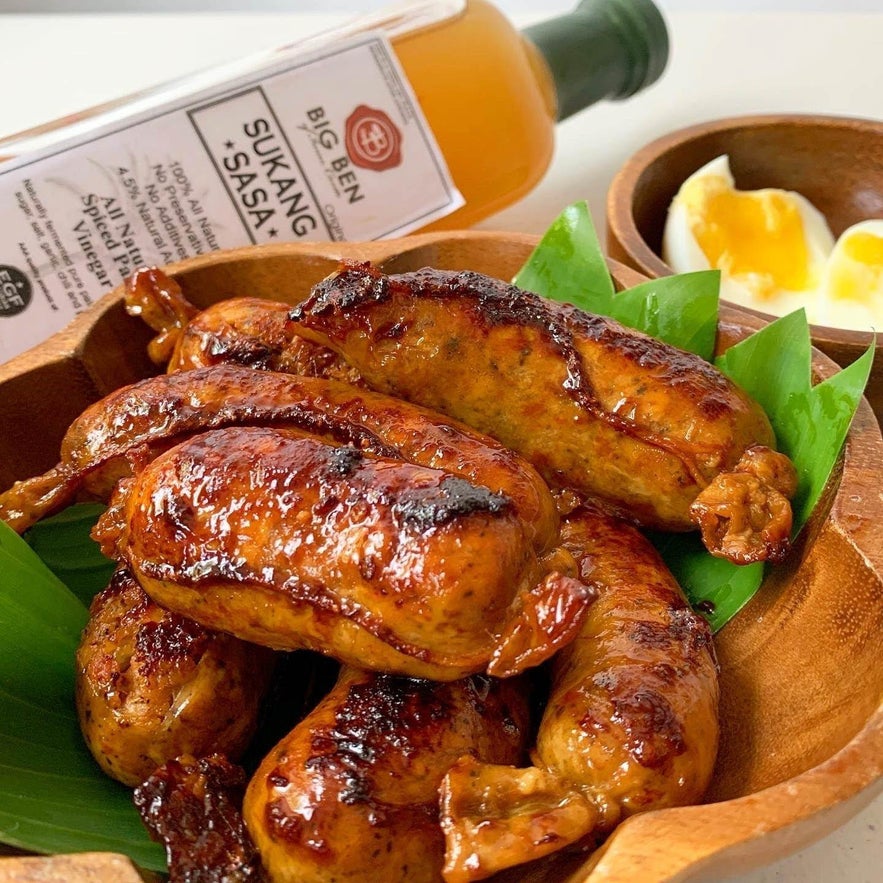
Photo by Big Ben's Kitchen
Probably not as well known as some of its older brothers, Cavite's Imus variety has a blend of soy sauce, vinegar, annatto, and black pepper that gives the mostly lean pork and a great balance of salty and sour flavors.
It goes really well with nipa palm vinegar. Try to look for these in public markets during your Cavite tours.
Guinobatan Longganisa
This longganisa could be the nation’s smallest and a must-buy when doing tours in Bicol. Each link is only about 2 inches long, and the meat is chopped by hand instead of being ground by a machine. This process gives these sausages a different, more substantial mouthfeel.
Pinuneg
It is not strictly a longganisa, although there are some who like to call it “Longganisa Dugo” (blood longganisa). Pinuneg is a blood sausage from the Northern Cordillera region in the mountainous regions of Luzon, which uses offal like the heart, liver, or lungs and the pig’s blood.
Stuffed with lots of garlic and then smoked before being fried, the sausage is rich and savory, best enjoyed with some vinegar.
Binalonan Longganisa
Another longganisa variety from the province of Pangasinan, this version may be lesser known than its cousin from Alaminos, but it is no less flavorful. The pork sausage is flavored with garlic and soy sauce, and it is encased in a sun-dried casing of pork intestine.
Chinese Chorizo
Sometimes called Chorizong Macau, these are Filipino versions of the Cantonese Lap Cheong sausage. They are sweet pork sausages that are dried. In the Philippines, they are rarely eaten alone. They usually appear in a lot of fried rice or stir fry recipes.
Start Planning Your Longganisa Food Tour!

Photo by Big Ben's Kitchen
It won’t be difficult to find longganisa when you come to the Philippines. Step foot in any Filipino market and it will be impossible to miss the numerous links of longganisa hanging by the butcher’s stall.
What will be difficult will be to establish which of the numerous longganisa types becomes one’s favorite. Skinless or with casing? De rekedo or hamonado? Salty, sweet or sour? The hunt for one’s favorite longganisa may not be an easy one, but it will definitely be a delicious one!



